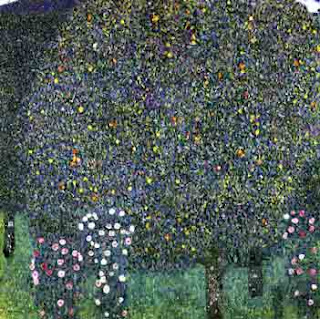I never knew my mother's mother; she died years before I was born and so I have never been comfortable referring to Florence Williams as my grandmother. My mother adored her mother, whose nickname was Billie, and often told stories about her and one of them was the genesis of this article.
During the Depression, when work for builders like my grandfather was nonexistent, Billie removed her wedding ring, took the train into Manhattan from Orange, New Jersey, and got a job as a receptionist at the Helena Rubinstein Salon on Fifth Avenue. Rubinstein had made her fortune with face creams, being the first to realize that if creams were marketed for day, night, and anti-wrinkle, the customer would buy three times as many jars. For years I have searched for pictures of that Salon, and here is one of the reception area by the esteemed architectural photographer Samuel Gottscho (1875-1971).
The cosmetics mogul brought her love of all things French with her when she came to New York. To design the salon, Rubinstein chose the Hungarian Ladislas Medgyes who had outfitted her New York apartment with its sensational clear dining suite made out of a new wonder material called lucite. Oak and leather stools were designed by Jean-Michel Frank, a rug was inspired by Fernand Leger who also painted the mural for Nelson Rockefeller’s east side townhouse. Presiding over all that luxe was the flattering portrait of Madame Rubinstein in a yellow shawl by Marie Laurencin. Also like Rockefeller, Rubinstein dotted her apartment with African sculptures and surrealist paintings. The rococo settee seen above in the Salon were a frequent Rubinstein accent.
 The Rockefellers, father John D. Rockefeller, Jr. and his son Nelson, were prominent Francophiles who had the means leave a mark on the city. Nelson's Fifth Avenue duplex, designed by Jean-Michel Frank, in 1937, was the setting for many events during his long career in the arts and in politics. (Frank, who was made a refugee by the Nazi occupation of his native France, jumped to his death from a tall New York building in 1941.) Meanwhile, John D.'s eponymous Rockefeller Center, under construction throughout the 1930s, was an extravagant love letter to all things French that has become, with time, an icon of American architecture. At its center is Paul Manship's golden Prometheus: "Prometheus, teacher in every art, brought the fire that hath proved to mortals a means to mighty ends." Rockefeller's kindred spirit, you could say.
The Rockefellers, father John D. Rockefeller, Jr. and his son Nelson, were prominent Francophiles who had the means leave a mark on the city. Nelson's Fifth Avenue duplex, designed by Jean-Michel Frank, in 1937, was the setting for many events during his long career in the arts and in politics. (Frank, who was made a refugee by the Nazi occupation of his native France, jumped to his death from a tall New York building in 1941.) Meanwhile, John D.'s eponymous Rockefeller Center, under construction throughout the 1930s, was an extravagant love letter to all things French that has become, with time, an icon of American architecture. At its center is Paul Manship's golden Prometheus: "Prometheus, teacher in every art, brought the fire that hath proved to mortals a means to mighty ends." Rockefeller's kindred spirit, you could say.As is often the case with love affairs, one party was more enthusiastic than the other. The French, their patented mixture of admiration laced with disdain, looked askance at the American skyscraper, finding something savage in this obelisk. They tried out a variety of metaphors to contain the heady experience of the vertical building, from mountains to cathedrals. The journalist, Jules Heret, sneered at them as “maisons geantes,” redeemed only by the magical aura cast by electricity. One critic even dismissed Cass Gilbert’s stately Woolworth Building as “banal and ineffective.” I could take this personally as my grandfather and grandmother had to postpone their wedding until October 16, 1913 so my Norman could finish working on the completion of the Woolworth tower. When the magazine Je sais tout published its first article about the construction of Rockefeller Center in December, 1931, the tone began to shift toward admiration for America’s “composition urbaniste,”
 Images:
Images:1. Samuel Gottscho - Helena Rubinstein salon in Manhattan, 1936, Museum of the City of New York.
2. Jean Lurcat - for Maison Mybor, hand-knotted wool rug, ca. 1930, Helen Rubenstein Collection, NYC.
3. unidentified photographer for Life Magazine - Helena Rubinstin in bed designed to her dimensions by Ladislas Medgyes, 1941, Museum of the City of New York.
4. Fernand Leger - design for fireplace mural for Nelson Rockefeller's New York townhouse, c. 1938, Davidson gallery, NYC.
5. unidentified photographer - Prometheus, designed by Paul Manship at Rockefeller Center Plaza, 1930s, New York Public Library.
6. Le Corbusier - Metamorphosis of a violin, 1922, Pompidou Center, Paris.




















